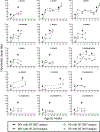Are Microneutralization and Hemagglutination Inhibition Assays Comparable? Serological Results from Influenza Experimentally Infected Mallard Ducks
- PMID: 31131570
- PMCID: PMC7213506
- DOI: 10.1637/11886-042718-Reg.1
Are Microneutralization and Hemagglutination Inhibition Assays Comparable? Serological Results from Influenza Experimentally Infected Mallard Ducks
Abstract
The hemagglutination inhibition (HI) assay is commonly used to assess the humoral immune response against influenza A viruses (IAV). However, the microneutralization (MN) assay has been reported to have higher sensitivity when testing sera from humans and other species. Our objective was to determine the agreement between MN and HI assays and compare the proportion of positive samples detected by both methods in sera of mallards primary infected with the A/mallard/MN/Sg-000169/ 2007 (H3N8) virus and subsequently inoculated with homosubtypic or heterosubtypic IAV. Overall, we found poor to fair agreement (prevalence-adjusted bias-adjusted kappa [PABAK], 0.03-0.35) between MN and HI assays in serum samples collected 2 weeks after H3N8 inoculation; the observed agreement increased to moderate or substantial in samples collected 4 to 5 weeks postinoculation (WPI) (PABAK, 0.52-0.75). The MN assay detected a higher proportion of positive samples compared with HI assays in serum samples collected 2 WPI (P = 0.01). This difference was not observed in samples collected 4 WPI. Also, a boosting effect in MN and HI titers was observed when birds were subsequently inoculated with IAV within the same H3 clade. This effect was not observed when birds were challenged with viruses that belong to a different HA clade. In summary, the agreement between assays varies depending on the postinfection sample collection time point and the similarity between the antigens used for the assays. Additionally, subsequent exposure of ducks to homosubtypic or heterosubtypic strains might affect the observed agreement.
¿Los ensayos de microneutralización e inhibición de la hemaglutinación son comparables? Resultados serológicos de patos de collar infectados experimentalmente con influenza. La prueba de inhibición de la hemaglutinación se usa rutinariamente para evaluar la respuesta inmune humoral contra los virus de influenza aviar, sin embargo, se ha reportado que la prueba de microneutralización tiene una mayor sensibilidad cuando se evalúan muestras de suero de humanos u otras especies. Este estudio tuvo como objetivo determinar la concordancia entre las pruebas de microneutralización e inhibición de la hemaglutinación en suero de patos de collar que fueron desafiados con el virus A/ mallard/MN/Sg-000169/2007(H3N8) y re-inoculados con virus de influenza aviar homosubtípicos o heterosubtípicos. Además, se comparó la proporción de muestras positivas detectadas por ambos métodos. En general, se observó un nivel de concordancia pobre a razonable (PABAK = 0.03 - 0.35) entre las pruebas de microneutralización e inhibición de la hemaglutinación en muestras de suero recolectadas dos semanas post-inoculación del virus H3N8. La concordancia se incrementó a moderada o sustancial en muestras recolectadas cuatro o cinco semanas después de la inoculación (PABAK = 0.52 - 0.75). Una mayor proporción de muestras recolectadas a las dos semanas después de la inoculación fueron positivas por microneutralización en comparación con inhibición de la hemaglutinación (P = 0.01), estas diferencias no fueron observadas con las muestras recolectadas a las cuatro semanas después de la inoculación. Adicionalmente, se observó un incremento en los títulos de anticuerpos cuando las aves fueron re-inoculadas con virus de influenza aviar pertenecientes al mismo clado H3 de la hemaglutinina. Este efecto no fue observado en los patos re-inoculados con virus de influenza aviar pertenecientes a un clado distinto. En resumen, la concordancia entre los ensayos varía según el momento de recolección de la muestra y la similitud entre los antígenos utilizados para los ensayos. Además, la re-inoculación de patos con una cepa homosubtípica or heterosubtípica podría afectar el nivel de concordancia observada.
Keywords: hemagglutination inhibition; influenza A virus; mallards; microneutralization; serology.
Figures

Similar articles
-
Comparison of serological assays for detecting antibodies in ducks exposed to H5 subtype avian influenza virus.BMC Vet Res. 2012 Jul 23;8:117. doi: 10.1186/1746-6148-8-117. BMC Vet Res. 2012. PMID: 22823985 Free PMC article.
-
Heterosubtypic immunity increases infectious dose required to infect Mallard ducks with Influenza A virus.PLoS One. 2018 Apr 26;13(4):e0196394. doi: 10.1371/journal.pone.0196394. eCollection 2018. PLoS One. 2018. PMID: 29698449 Free PMC article.
-
Consecutive natural influenza a virus infections in sentinel mallards in the evident absence of subtype-specific hemagglutination inhibiting antibodies.Transbound Emerg Dis. 2013 Oct;60(5):395-402. doi: 10.1111/j.1865-1682.2012.01357.x. Epub 2012 Jul 22. Transbound Emerg Dis. 2013. PMID: 22816511
-
Differential Viral Fitness Between H1N1 and H3N8 Avian Influenza Viruses Isolated from Mallards (Anas platyrhynchos).Avian Dis. 2015 Dec;59(4):498-507. doi: 10.1637/11074-033015-Reg. Avian Dis. 2015. PMID: 26629623
-
Testing human sera for antibodies against avian influenza viruses: horse RBC hemagglutination inhibition vs. microneutralization assays.J Clin Virol. 2008 Sep;43(1):73-8. doi: 10.1016/j.jcv.2008.04.013. Epub 2008 Jun 19. J Clin Virol. 2008. PMID: 18571465 Free PMC article.
Cited by
-
Antibody prevalence to avian influenza virus subtypes H5, H7 and H9 in falcons, captive and wild birds, United Arab Emirates, 2003-2006.Vet Med Sci. 2023 Jul;9(4):1890-1900. doi: 10.1002/vms3.1156. Epub 2023 May 24. Vet Med Sci. 2023. PMID: 37226651 Free PMC article.
-
Long-term immune responses induced by low-dose infection with high pathogenicity avian influenza viruses can protect mallards from reinfection with a heterologous strain.Arch Virol. 2025 Jan 9;170(2):33. doi: 10.1007/s00705-024-06209-x. Arch Virol. 2025. PMID: 39779578 Free PMC article.
-
Are we serologically prepared against an avian influenza pandemic and could seasonal flu vaccines help us?mBio. 2025 Feb 5;16(2):e0372124. doi: 10.1128/mbio.03721-24. Epub 2024 Dec 31. mBio. 2025. PMID: 39745389 Free PMC article.
-
A Bioluminescent Imaging Mouse Model for Seasonal Influenza Virus Infection Based on a Pseudovirus System.Viruses. 2025 May 9;17(5):686. doi: 10.3390/v17050686. Viruses. 2025. PMID: 40431697 Free PMC article.
References
-
- Alexander DJ A review of avian influenza in different bird species. Vet Microbiol 74:3–13. 2000. - PubMed
-
- Ito T, Suzuki Y, Mitnaul L, Vines A, Kida H, and Kawaoka Y Receptor specificity of influenza A viruses correlates with the agglutination of erythrocytes from different animal species. Virology 227:493–499. 1997. - PubMed
Publication types
MeSH terms
Substances
Grants and funding
LinkOut - more resources
Full Text Sources
Medical

